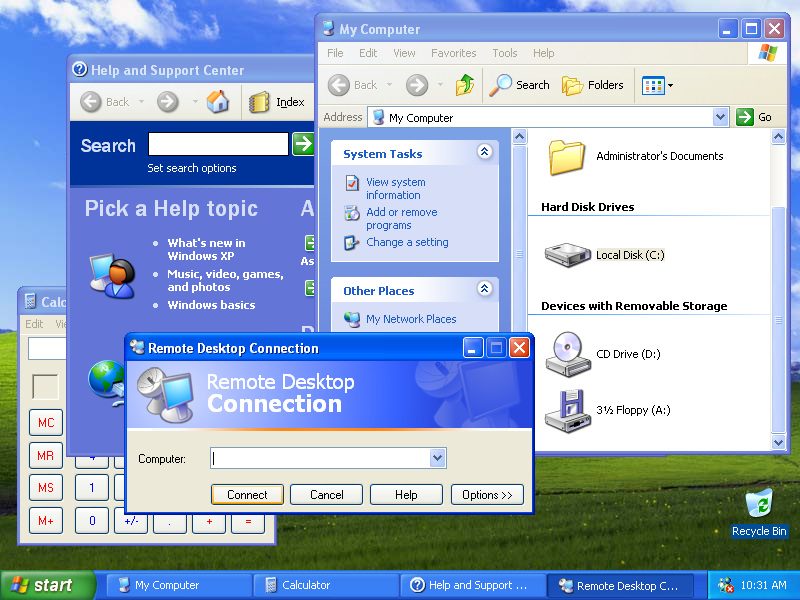Matt and Devin's guide to Desktop Operating Systems


Windows is Microsoft's desktop and server series of operating systems. The majority of desktop computers run some version of Windows. Originally, Windows was built as a competitor to Apple's Mac OS. In its early days, it struggled to gain users, as its interface was fairly clunky and the system had many bugs. As Microsoft inovated and introduced features that made Apple's system less competitive, people began to move to Windows en masse. Apple's restrictions on the hardware that Mac OS could run on further contributed to the Windows userbase once people could get comparable Windows computers for a fraction of the price.
Through the years, Microsoft has continued to develop Windows, adding features and streamlining their design. While this has usually worked in their favor (with XP, 7, and 10), this strategy has failed them before (ME, Vista, 8/8.1). Given that Microsoft tends to have a fairly even cycle of releases, where each successful release is typically followed by an unsuccessful one, many people opt to use every other version of Windows. The current version of Windows, Windows 10, takes the best elements from its two previous releases, Windows 7 and Windows 8.1, and combines them in its new interface.
Windows is the most common desktop OS in the world. As such, Windows is basically for everyone. There are business-oriented features, content-creation features, video gaming features, software development features, and more.
There are several different editions of Windows, tailored to different use-cases and price ranges. The most common editions consumers will see are Windows 10 Home, Home S, Pro, and Pro S. Further editions are available depending on use environment and PC hardware. Windows 10 Pro for Workstations, Windows 10 Enterprise, and Windows 10 Education are available for more professional use cases.
Microsoft has seen its fair share of controversy surrounding Windows and its implementation. From the 1998 "Windows Tax" case through the Internet Explorer antitrust suit all the way up to Windows 10's forced roll out and telemetry issues, many people have a lot to say about Microsoft.
Early on, many users of free operating systems banded together against Microsoft. About every PC vendor at the time included Windows by default and had no offerings that didn't include it (per agreements with Microsoft). As such, users were forced to pay for Windows even if they had no intention to use it. This became known as the "Windows Tax" or "Microsoft Tax" to users of free operating systems like FreeBSD and Linux. Microsoft poised this as an anti-piracy measure, but was defeated. This forced them to end their limitations on computers sold without operating systems. This was covered in the case in the next paragraph.
When Microsoft bundled Internet Explorer with their computers, an antitrust case against the company was formed. It was said that Microsoft was trying to discourage competition from the likes of Netscape and AOL, both makers of web browsing software, by including their own web browser which used open AND proprietary standards. Microsoft lost this case as well and was forced to separate its software development from its OS development.
Windows 10 has been the center of several major issues. Microsoft forced Windows 10 onto many computers whose users declined the Windows 10 upgrade by changing how their update dialogues worked and making it more difficult for users to opt out. Because of hardware incompatibility issues, this caused many peoples' computers to be unusable for a time while they created recovery media for their original Windows version and repaired their computers. On top of all those problems, Microsoft has enabled collection of user and system data in Windows 10 with no way to completely disable this data collection in Home and Pro versions.

Windows 3.1 - Note the lack of Start Menu and standard window controls. (image credit: Guidebook)

Windows 95 - first version of Windows to include the now-standard Start Menu and window controls. (image credit: Guidebook)

Windows XP introduced a new style with more color and revamped UI elements. (image credit: Guidebook)

Windows 7 built on Windows Vista's UI changes with a lighter interface that was almost universally praised. The main features added were Aero Glass and Aero Snap, giving windows a translucent titlebar and allowing them to "snap" to sides of the screen. (image credit: Ars Technica)

Windows 8 introduced a new style with a controversial new Start screen instead of a Start menu. Its desktop got rid of Aero Glass in favor of matte colored title bars. The Aero Snap function was preserved. (image credit: Mayotte-occasions)

Windows 10 dialed back the tablet-heavy UI with a more traditional Start menu which had the menu elements and search from Windows 7 and the Live Tiles from Windows 8. Also making a come back is translucency in windows and the start menu. (image credit: S Tech.bd)